Rs. 40 b Upper Kotmale hydropower project gets under way
By P. Krishnaswamy
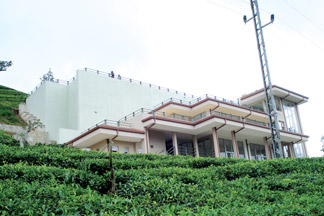
A viewing gallery for tourists built by the CEB overlooking St.
Clair falls. |
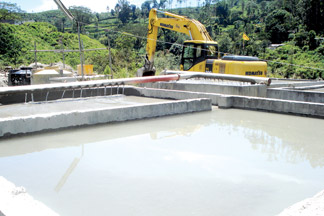
The treatment plant for chemically and physically treating waste
water before releasing into the river. |
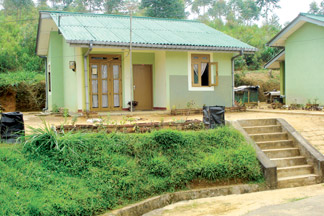
Some of the independent housing units of the resettled families. |
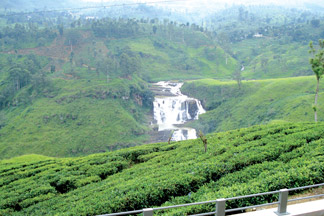
A panoramic view of the St. Clair Waterfall. |
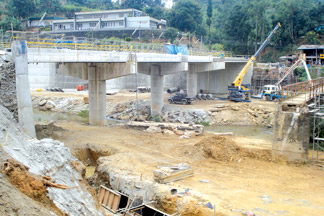
Bridge No. 02 constructed over the Kotmale Oya connecting
the A7 Road and the Great Western Road. Ninety percent of the
work has been completed and the bridge will be open for traffic
in March 2012. |
The much-awaited Rs.40 billion Upper Kotmale Hydropower Project
(UKHP) that was started in 2005 has now been completed and will add 150
MW power to the national grid early next month. The Japanese-funded
project was meticulously planned and executed to adequately address all
concerns over environment,Bio diversity, displacement of families and
the preservation of the landscape and its natural beauty.
The test filling of the reservoir will be completed in the middle of
this month followed by connecting to the national grid and a test run.
The Sunday Observer staffer visited the project site in Talawakelle
and met Project Director Shavindranath Fernando and senior officials at
the site, including the environmental and resettlement officers.
They explained the various aspects of the project, the environmental
protection measures, rehabilitation of the large number of displaced
families , housing and livelihood assistance that are being provided to
them, community welfare measures as well as tree cover and afforestation
measures in the catchment areas. The project has invigorated the living
standards of the people in the Talawakelle and the surrounding areas.
Although it was to be launched in the 1980s, it never saw the light of
the day due to political expediency and various other reasons and
intimidation, until President Mahinda Rajapaksa came to power in 2005
and took the bold decision to proceed with the construction of the
project.
On July 27, 2005 the contracts relating to the preparatory work was
awarded to the Maeda Corporation of Japan. Since then the project has
proceeded smoothly surmounting all obstacles providing a ray of hope to
the people of Talawakelle and Kotmale areas and progressing as a pillar
of the energy sector that would be one of the significant contributory
factors towards achieving the goal of transforming Sri Lanka as the
wonder nation of Asia.
Under the project the water of the Kotmale Oya gets diverted from the
head pond through the intake, from which the water enters into the
13-km-long headrace mountain tunnel, the longest in the country,The icon
of this massive project is the 5.8 M width tunnel that runs cutting
through the Talawakelle-Niyamgambora mountain range. The headrace tunnel
conveys the water to the powerhouse cavern, through the inclined
penstock tunnel, where two Francis turbine units have been installed.
The Overseas Economic Cooperation Fund (OECF) of Japan funded the
conceptual design, environmental Impact assessment and the final design.
The Secretary of the Ministry of Forestry and Environment gave the
final clearance to implement the project subject to the strict adoption
of the proposed mitigation measures in accordance with the National
Environment Act No.47 of 1980 (Amended Act No.56 of 1988). The Central
Environment Authority (CEA) appointed an Environment Monitoring
Committee (EMC) to evaluate the implementing of the proposed mitigation
measures by the CEB.
Of the total 495 families that were displaced or affected under the
project, 430 families have already been resettled in independent or twin
modern housing units and compensations were paid those families which
had lost their agricultural/home garden plots.
Contracts have already been awarded for the construction of housing
units to the remaining 65 families and the work is anticipated to be
completed within nine months. Many of them were living in tin-roofed
line rooms which had one veranda and a room with no separate kitchen or
bathroom facility, forcing many families to use one bathroom.
The most glaring and picturesque sight was the green colour-roofed
housing units dotting as several units in the adjoining high elevated
areas. The housing complexes include 33 shops, community centers, Hindu
temples and churches. Seventy-five percent of these families are Tamils
while 22 percent are Sinhalese and three percent Muslims.
The resettlement of the families were done under the Resettlement
Action Plan (RAP) taking into consideration the magnitude of the social
impacts, restoration and improvement of the living standards of the
families, enhancement of income earning capacity, increasing levels of
production and also uplifting their general well being.
Aside from the home garden program, micro financing schemes and OSD
training programs have also been implemented under the Income
Enhancement Programs for the families.
Under the home-garden program, fruit plants are being distributed to
the families periodically. Pears, mandarin and apple plants and
vegetable seeds are being distributed among them.
Agricultural implements such as mammoty, garden fork and watering
bucket have also been been distributed to the families. Under a new home
garden package three varieties of vegetable seeds and fertilizers are to
be distributed to the families for their first crop.
The measures that have been taken to safeguard the environment and
mitigation programs implemented by the Environment Management Office
(EMO) of the UKHP include monitoring of air quality, noise and vibration
at construction sites; surface water quality monitoring of streams of
the project area on a monthly basis; implementation of recommendations
of Bio diversity assessment conducted by IUCN of the streams impacted by
the project ; ground water level and surface water discharge monitoring
along the tunnel route on a weekly basis ; map out of the existing
landslides and potential areas, within the project, foot prints in order
to mitigate any adverse impact ; stream flow measurement and sediment
load monitoring ; and standardised photographic record of the St.Clair
Waterfall on a monthly basis. A comprehensive Watershed Management Plan
that has been prepared by the CEB and implemented by the EMO include
gully conservation, conservation-oriented agriculture, increasing the
tree cover- afforestation, river bank protection with bamboo tree
plantation, tree planting to enhance water table, improvement of poorly
managed/degraded tea land, protection of land slide prone areas, fire
protection, implementation of fire belts, proper disposal of earth and
garbage and conservation of roads, road drains and roadsides.
Under these programs 83,000 bamboo plants have already been
established in 16 estates in the catchment areas. 190,000 eucalyptus
plants in 13 estates and 14,500 plants of native spices have been
cultivated in five estates. Distribution of fruit plants to the
resettled families and a large number of trees have been planted under
the tree planting campaign. |

